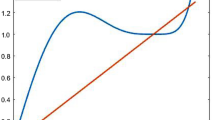Abstract
This paper describes a new space-time coding scheme for non-coherent multi-antenna multi-input multi-output (MIMO) systems. This new MIMO scheme merges error-correcting and space-time coding functions by transmitting invertible matrices, so this scheme has been called “Matrix Coded Modulation” or “MCM”. Coherent systems require channel state information (CSI) at the transmitters and/or at the receivers, and their performances strongly depend on the channel estimation. For example, in systems using Orthogonal frequency division multiplexing, the channel estimation requires the insertion of pilot-symbols in the transmitted frame which implies a spectral efficiency loss of the global system that increase with the number of transmit antennas. The existing non-coherent schemes such as the differential space-time modulation leads to performance degradation compared to coherent systems in which perfect CSI is assumed. Decoding in the MCM scheme is performed iteratively, based on a specified detection criteria. In the proposed MCM scheme, decoding can be achieved with or without CSI at the receiving antennas. As the space-time coding function is merged with the error-correcting code, the euclidean distances distribution between modulated signals based on the detection criteria is strongly linked to the Hamming weights distribution of the channel error-correcting code used in the MCM scheme. Moreover, a low-complexity decoding algorithm is described and compared to the existing differential schemes.










Similar content being viewed by others
References
Alamouti, S. (1998). A simple transmit diversity technique for wireless communications. IEEE Journal on Selected Areas in Communications, 16, 1451–1458.
Tarokh, V., Jafarkhani, H., & Calderbank, A. R. (1999). Space-time block bodes from orthogonal designs. IEEE Transactions on Information Theory, 45(5), 1456–1467.
Pauli, V., Cocke, J., Lampe, L., & Huber, J. (2008). Differential space-frequency modulation and fast 2-D multiple-symbole differential detection for MIMO-OFDM. IEEE Transactions on Vehicular Technology, 57(1), 297–310.
Hochwald, B. M., & Marzetta, T.L. (2000, March). Differential unitary space-time modulation for multiple-antenna communications in Rayleigh flat fading. IEEE Transactions on Information theory, 46(2).
Hughes, B. L. (2000). Differential space-time modulation. IEEE Transactions on Information Theory, 46(7), 2567–2578.
Schlegel, C., & Grant, A. (2003). Differential space-time turbo codes. IEEE Transactions on Information theory, 49(9), 2298–2306.
Tarokh, V., & Jafarkhani, H. (2000). A differential detection scheme for transmit diversity. IEEE Journal on Selected Areas in Communications, 18(7), 1169–1174.
MacWilliams, F. J., & Sloane, N. J. A. (1977). The theory of error-correcting codes, Ed. North-Holland, 1977, Chapter 19, Paragraph 3.
Forney, G. D, Jr. (1973). The viterbi algorithm. Proceedings of the IEEE, 61(3), 268–278.
Cadic, E., Carlach, J. C., Olocco, G., Otmani, A., & Tillich, J. P. (2001). Low complexity Tail-Biting trellises of self-dual codes of length 24, 32 and 40 over GF(2) and Z4 of large minimum distance. In Proceedings of the 14th international symposium on applied algebra, algebraic algorithms and error-correcting codes, AAECC-14 (pp. 57–66).
Carlach, J.-C., & Otmani, A. (2003). A systematic construction of self-dual codes. IEEE Transactions on Information Theory, 49(11), 3005–3009.
Berrou, C., Glavieux, A., & Thitimajshima, P. (1993, May). Near Shannon limit error-correcting and decoding: Turbo-Codes. In Proceedings of the IEEE international conference on, communications (ICC’93) (pp. 1064–1070), Geneva (Switzerland).
Calderbank, A. R., & Forney, G. D, Jr. (1999). Minimal tail-biting trellises: The golay code and more. IEEE Transactions on Information Theory, 45(5), 1435–1455.
Le Saux, B., Hélard, M., & Bouvet, P.-J. (2005, September). Comparison of coherent and non-coherent space-time schemes for frequency selective fast varying channels. In International symposium on wireless communication systems (ISWCS’05). Sienna, Italy.
Author information
Authors and Affiliations
Corresponding author
Rights and permissions
About this article
Cite this article
El Arab, A., Carlach, JC. & Hélard, M. Matrix Coded Modulation: A New Non-coherent MIMO Scheme. Wireless Pers Commun 72, 1587–1601 (2013). https://doi.org/10.1007/s11277-013-1122-z
Published:
Issue Date:
DOI: https://doi.org/10.1007/s11277-013-1122-z




